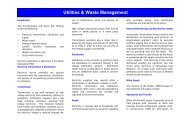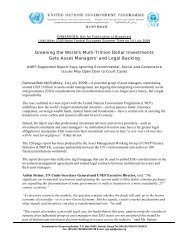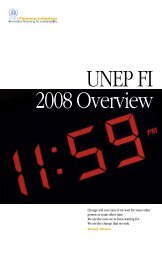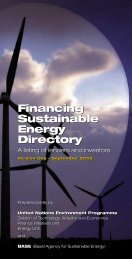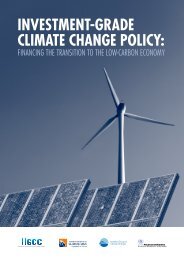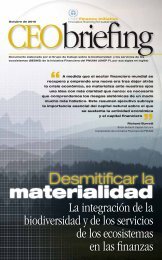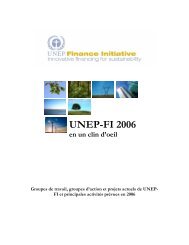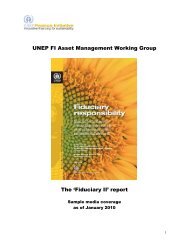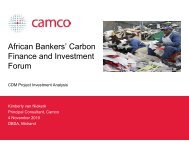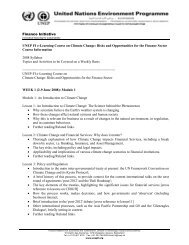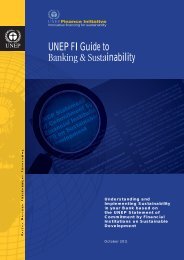for Business - TEEB
for Business - TEEB
for Business - TEEB
Create successful ePaper yourself
Turn your PDF publications into a flip-book with our unique Google optimized e-Paper software.
T h e E c o n o m i c s<br />
o f E c o s y s t e m s<br />
& B i o d i v e r s i t y<br />
<strong>TEEB</strong> FOR BUSINESS<br />
EXECUTIVE SUMMARY
Photos: Cover and title page, all images UNEP/Topham
T h e E c o n o m i c s<br />
o f E c o s y s t e m s<br />
& B i o d i v e r s i t y<br />
THE ECONOMICS OF ECOSYSTEMS AND BIODIVERSITY<br />
REPORT FOR BUSINESS<br />
EXECUTIVE SUMMARY
Citation<br />
This report should be quoted as follows:<br />
<strong>TEEB</strong> – The Economics of Ecosystems and Biodiversity<br />
Report <strong>for</strong> <strong>Business</strong> - Executive Summary 2010<br />
Authorship<br />
This executive summary has been written by:<br />
Joshua Bishop (International Union <strong>for</strong> Conservation of<br />
Nature), Nicolas Bertrand (United Nations Environment<br />
Programme), William Evison (PricewaterhouseCoopers),<br />
Sean Gilbert (Global Reporting Initiative),<br />
Annelisa Grigg (Global Balance), Linda Hwang (<strong>Business</strong><br />
<strong>for</strong> Social Responsibility), Mikkel Kallesoe (World<br />
<strong>Business</strong> Council <strong>for</strong> Sustainable Development),<br />
Alexandra Vakrou (European Commission), Cornis van<br />
der Lugt (United Nations Environment Programme),<br />
Francis Vorhies (Earthmind)<br />
<strong>TEEB</strong> <strong>for</strong> <strong>Business</strong> Co-ordinator: Joshua Bishop<br />
(International Union <strong>for</strong> Conservation of Nature)<br />
Disclaimer: The views expressed in this report are<br />
purely those of the authors and may not in any<br />
circumstances be regarded as stating an official<br />
position of the organisations involved.<br />
ISBN 978-3-9813410-1-0<br />
Layout by www.dieaktivisten.de<br />
Printed by Progress Press, Malta<br />
<strong>TEEB</strong> is hosted by the United Nations Environment Programme and supported by the European Commission;<br />
the German Federal Environment Ministry; the UK Government’s Department <strong>for</strong> Environment, Food and Rural<br />
Affairs; UK Department <strong>for</strong> International Development, Norway’s Ministry <strong>for</strong> Foreign Affairs; The Netherlands'<br />
Interministerial Program Biodiversity; and the Swedish International Development Cooperation Agency.
<strong>TEEB</strong> <strong>for</strong> <strong>Business</strong> – Executive Summary<br />
TABLE OF CONTENTS<br />
Foreword<br />
1. Introduction and overview 1<br />
2. The world is waking up to biodiversity loss 2<br />
3. Biodiversity provides valuable ecosystem services free of charge 3<br />
4. The first step <strong>for</strong> business is to identify impacts and dependencies 4<br />
5. <strong>Business</strong> is beginning to measure and report impacts, dependencies and responses 6<br />
6. <strong>Business</strong> is finding new ways to reduce biodiversity and ecosystem risks 9<br />
7. <strong>Business</strong> can conserve biodiversity and deliver ecosystem services 10<br />
8. Synergies exist between business, biodiversity and social development 12<br />
9. <strong>Business</strong> can take action and achieve more in partnerships 13<br />
References 16
The Economics of Ecosystems and Biodiversity:<br />
Report <strong>for</strong> <strong>Business</strong><br />
FOREWORD<br />
Modern society’s predominant focus on marketdelivered<br />
components of well-being, and our almost<br />
total dependence on market prices to indicate value,<br />
means that we generally do not measure or manage<br />
economic values exchanged other than through markets.<br />
This is especially true of the public goods and<br />
services that comprise a large part of the benefits that<br />
nature provides humanity.<br />
Society generally also ignores third-party effects of<br />
private exchanges (so-called ‘externalities’) unless<br />
they are actually declared illegal. <strong>TEEB</strong> has assembled<br />
much evidence that the economic invisibility of<br />
nature’s flows into the economy is a significant<br />
contributor to the degradation of ecosystems and the<br />
loss of biodiversity. This in turn leads to serious<br />
human and economic costs which are being felt now,<br />
have been felt <strong>for</strong> much of the last half-century, and<br />
will be felt at an accelerating pace if we continue<br />
‘business as usual’.<br />
There are both serious risks to business, as well as<br />
significant opportunities, associated with biodiversity<br />
loss and ecosystem degradation. There is also a need<br />
<strong>for</strong> business to quantify and value its impacts on biodiversity<br />
and ecosystems, in order to manage these<br />
risks and opportunities and enable a better future <strong>for</strong><br />
all.<br />
Evaluations of any kind are a powerful ‘feedback<br />
mechanism’ <strong>for</strong> a society which has distanced itself<br />
from the biosphere, upon which its very health and<br />
survival depends. Economic valuations, in particular,<br />
communicate the value of ecosystems and biodiversity<br />
and their largely unpriced flows of public goods<br />
and services in the language of the world’s dominant<br />
economic and political model. Mainstreaming this<br />
thinking and bringing it to the attention of policymakers,<br />
administrators, businesses and citizens is<br />
in essence the central purpose of <strong>TEEB</strong>, and this<br />
summary report on <strong>TEEB</strong> <strong>for</strong> <strong>Business</strong> is an important<br />
contribution towards that objective.<br />
Pavan Sukhdev,<br />
<strong>TEEB</strong> Study Leader
1. INTRODUCTION AND OVERVIEW<br />
The Economics of Ecosystems and Biodiversity (<strong>TEEB</strong>)<br />
is a global study, initiated by the G8 and five major<br />
developing economies and focusing on ‘the global economic<br />
benefit of biological diversity, the costs of the loss<br />
of biodiversity and the failure to take protective measures<br />
versus the costs of effective conservation’ 1 . <strong>TEEB</strong> makes<br />
the case <strong>for</strong> integrating the economics of biodiversity and<br />
ecosystem services in decision-making.<br />
This document summarizes a major component of <strong>TEEB</strong><br />
aimed at the business community (‘<strong>TEEB</strong> <strong>for</strong> <strong>Business</strong>’<br />
or Deliverable 3). The full report sets out the business<br />
case <strong>for</strong> biodiversity and ecosystem services (BES).<br />
In this summary, we review some key indicators and<br />
drivers of biodiversity loss and ecosystem decline, and<br />
show how this presents both risks and opportunities to<br />
business. We examine the changing preferences of<br />
consumers <strong>for</strong> nature-friendly products and services,<br />
and offer some examples of how companies are<br />
responding; more detail is provided in Chapter 1 of the<br />
full report.<br />
Here we summarize the links between business and biodiversity,<br />
focusing on the concept of ecosystem services.<br />
More detail on the status of and trends in biodiversity and<br />
ecosystem services, and the BES impacts and dependencies<br />
of different business sectors, is provided in<br />
Chapter 2 of the full report.<br />
This summary and Chapter 3 of the full report describe<br />
recent initiatives to enable businesses to measure, value<br />
and report their impacts and dependencies on biodiversity<br />
and ecosystem services, and outline further work<br />
needed in this area. We identify practical tools to manage<br />
BES risks and show how companies are using these<br />
tools to deliver business value, with many more examples<br />
provided in Chapter 4 of the full report.<br />
We highlight some emerging business models that deliver<br />
biodiversity benefits and ecosystem services on a<br />
commercial basis, and review the enabling frameworks<br />
needed to stimulate private investment and entrepreneurship<br />
to realize such opportunities, as well as<br />
obstacles. Chapter 5 of the full report explores this topic<br />
in detail, offering a wealth of concrete examples.<br />
This summary briefly reviews how business can align<br />
their actions in relation to biodiversity and ecosystem<br />
services with wider corporate social responsibility initiatives,<br />
including community engagement and poverty reduction.<br />
This is developed further in Chapter 6 of the full<br />
report.<br />
Finally, Chapter 7 of the full report and this summary<br />
conclude with a review of business and biodiversity initiatives<br />
and an agenda <strong>for</strong> action by business as well as<br />
other stakeholders. Our key points are summarized<br />
below (Box 1).<br />
Box 1: Key action points <strong>for</strong> business<br />
1. Identify the impacts and dependencies of your business on biodiversity and ecosystem services (BES)<br />
2. Assess the business risks and opportunities associated with these impacts and dependencies<br />
3. Develop BES in<strong>for</strong>mation systems, set SMART targets, measure and value per<strong>for</strong>mance, and<br />
report your results<br />
4. Take action to avoid, minimize and mitigate BES risks, including in-kind compensation (‘offsets’)<br />
where appropriate<br />
5. Grasp emerging BES business opportunities, such as cost-efficiencies, new products and new<br />
markets<br />
6. Integrate business strategy and actions on BES with wider corporate social responsibility initiatives<br />
7. Engage with business peers and stakeholders in government, NGOs and civil society to improve<br />
BES guidance and policy<br />
T E E B F O R B U S I N E S S – E X E C U T I V E S U M M A R Y 1
2. THE WORLD IS WAKING UP TO<br />
BIODIVERSITY LOSS<br />
Evidence of global decline in biological diversity<br />
(‘biodiversity’) is incontrovertible. Most indicators of<br />
the state of biodiversity show declines, indicators of<br />
pressures on biodiversity show increases, and despite<br />
some local successes and responses, the rate of biodiversity<br />
loss does not appear to be slowing 2 . Other assessments<br />
of ecological decline are equally disturbing 3 .<br />
The direct drivers of biodiversity loss include habitat loss<br />
and degradation, climate change, pollution, over-exploitation<br />
and the spread of invasive species 4 . Projections<br />
of the impacts of climate change, in particular, show<br />
continuing changes in the distribution and abundance of<br />
species and habitats, resulting in increasing species extinction<br />
5 .<br />
Public awareness of biodiversity loss is increasing,<br />
leading to changes in consumer preferences and<br />
purchasing decisions. Consumers are more concerned<br />
about the environment today than just five years<br />
ago 6 . NGO campaigns, scientific research and media attention<br />
are part of the reason <strong>for</strong> this change but businesses<br />
are also showing leadership, as indicated by the<br />
development of ‘corporate social responsibility’ initiatives.<br />
As a result, more and more consumers are favouring<br />
ecologically-certified goods and services (Box 2).<br />
This in turn increases pressure on business to review<br />
their value chains in order to ensure continued access<br />
to market, security of supply, and protect against<br />
reputational risk. In some cases, certification may be a<br />
requirement <strong>for</strong> market entry, while in others it may be a<br />
means to secure or increase market share 7 .<br />
The financial services industry is starting to ask<br />
questions about biodiversity and ecosystems.<br />
Investors are exploring new opportunities linked to biodiversity<br />
and ecosystem services but they are also increasingly<br />
concerned about potential risks 13 . This is<br />
especially the case in the area of project finance and reinsurance<br />
14 . Strategies employed include ‘red-lining’ investments<br />
in areas of high biodiversity, developing sector<br />
guidelines <strong>for</strong> environmentally sensitive sectors (<strong>for</strong><br />
example, Rabobank has specific requirements regarding<br />
impacts on biodiversity <strong>for</strong> palm oil and soya), refraining<br />
from financing sectors in which a bank lacks specialist<br />
knowledge, and working with borrowers to improve their<br />
environmental per<strong>for</strong>mance and to mitigate harm 15 .<br />
<strong>Business</strong> is beginning to notice the threat posed<br />
by biodiversity loss 16 . 27% of global CEOs surveyed<br />
by PwC in 2009 expressed concern about the impacts of<br />
biodiversity loss on their business growth prospects 17 .<br />
Those expressing concern were more numerous in<br />
industries characterized by large direct impacts on biodiversity<br />
and in developing regions (Figure 1).<br />
Box 2: Growth in eco-certified products and services<br />
• Global sales of organic food and drink amounted to US$ 46 billion in 2007, a threefold increase<br />
since 1999 8 .<br />
• US organic food sales alone accounted <strong>for</strong> 3.5% of the nation’s food market and increased by<br />
15.8% in 2008, more than triple the growth rate of the food sector as a whole in the same year 9,10 .<br />
• Sales of certified ‘sustainable’ <strong>for</strong>est products quadrupled between 2005 and 2007 11 .<br />
• Between April 2008 and March 2009, the global market <strong>for</strong> eco-labelled fish products grew<br />
by over 50%, attaining a retail value of US$ 1.5 billion 12 .<br />
• In 2008-09, several brand owners and retailers added ‘ecologically-friendly’ product attributes<br />
to their major consumer brands, often through independent certification schemes, including Mars<br />
(Rain<strong>for</strong>est Alliance cocoa), Cadbury (Fairtrade cocoa), Kraft (Rain<strong>for</strong>est Alliance Kenco coffee),<br />
and Unilever (Rain<strong>for</strong>est Alliance PG Tips).<br />
2 T E E B F O R B U S I N E S S – E X E C U T I V E S U M M A R Y
Figure 1: Views of global CEOs on the threat to business growth from biodiversity loss<br />
Source: PricewaterhouseCoopers 13th Annual Global CEO Survey 2010<br />
3. BIODIVERSITY PROVIDES VALUABLE<br />
ECOSYSTEM SERVICES FREE OF CHARGE<br />
Environmentalists increasingly frame their analysis<br />
of biodiversity loss in terms of the benefits<br />
or ‘ecosystem services’ provided to people 18 .<br />
Ecosystem services enjoyed by people are economically<br />
significant and depend on both the diversity<br />
(quality) as well as the sheer amount (quantity) of<br />
genes, species and ecosystems found in nature<br />
(Table 1) 19 .<br />
Scenario projections <strong>for</strong> the period 2000-2050 suggest<br />
continued improvement in so-called ‘provisioning’<br />
services (mainly food and other commodities),<br />
achieved through increased conversion of habitats<br />
and at the likely cost of further degradation in what<br />
the Millennium Ecosystem Assessment defined as<br />
‘supporting, regulating and cultural’ services 20 . Continued<br />
rapid loss of biodiversity may further compromise<br />
future supplies of ecosystem services and associated<br />
economic output 21 .<br />
Biodiversity loss cannot be seen in isolation from<br />
other trends. The economic value of biodiversity and<br />
ecosystem services is a function of demand-side<br />
factors or underlying drivers of change (e.g., population<br />
growth and urbanization, economic growth,<br />
changing politics, preferences and environmental policy,<br />
developments in in<strong>for</strong>mation and technology), as<br />
well as supply-side constraints (e.g., climate change,<br />
increasing scarcity of natural resources and/or declining<br />
quality of ecosystem services). Biodiversity loss<br />
and ecosystem decline are often closely linked to<br />
these and other major trends affecting business (see<br />
Chapter 1 in the <strong>TEEB</strong> <strong>for</strong> <strong>Business</strong> report).<br />
T E E B F O R B U S I N E S S – E X E C U T I V E S U M M A R Y 3
Table 1: Relationship between biodiversity, ecosystems and ecosystem services<br />
Biodiversity<br />
Ecosystems<br />
(variety &<br />
extent/area)<br />
Species<br />
(diversity &<br />
abundance)<br />
Genes<br />
(variability &<br />
population)<br />
Ecosystem goods and<br />
services (examples)<br />
• Recreation<br />
• Water regulation<br />
• Carbon storage<br />
• Food, fibre, fuel<br />
• Design inspiration<br />
• Pollination<br />
• Medicinal discovery<br />
• Disease resistance<br />
• Adaptive capacity<br />
Economic values (examples)<br />
Avoiding GHG emissions by conserving <strong>for</strong>ests:<br />
US$ 3.7 trillion (NPV) 22<br />
Contribution of insect pollinators to agricultural<br />
output: ~US$ 190 billion/year 23<br />
25-50% of the US$ 640 billion pharmaceutical<br />
market is derived from genetic resources 24<br />
4. THE FIRST STEP FOR BUSINESS IS TO<br />
IDENTIFY IMPACTS AND DEPENDENCIES<br />
Far-sighted businesses can create opportunities<br />
from the greening of investor, client and consumer<br />
preferences. <strong>Business</strong> can influence consumer choice<br />
and behaviour by providing in<strong>for</strong>mation about the sustainability<br />
of their products, as well as how to use and<br />
dispose of them responsibly. Companies can also develop<br />
‘smarter’ products and services that help clients<br />
reduce their ecological footprint. The first step is <strong>for</strong><br />
businesses to identify the impacts and dependencies of<br />
their products and services on biodiversity and ecosystem<br />
services (see Chapter 2 in the <strong>TEEB</strong> <strong>for</strong> <strong>Business</strong><br />
report).<br />
All business depend on biodiversity and ecosystem<br />
services, directly or indirectly; most businesses<br />
also have impacts on nature, positive or<br />
negative. <strong>Business</strong>es that fail to assess their impacts<br />
and dependence on biodiversity and ecosystem services<br />
carry undefined risks and may neglect profitable<br />
opportunities (Box 3).<br />
4 T E E B F O R B U S I N E S S – E X E C U T I V E S U M M A R Y
Box 3: De<strong>for</strong>estation in China: Implications <strong>for</strong> the construction sector<br />
Over the period 1949-1981 China logged some 75 million hectares, 92% of which were natural rather than<br />
plantation <strong>for</strong>ests, to satisfy demand <strong>for</strong> timber <strong>for</strong> construction and other uses. The ensuing rapid de<strong>for</strong>estation<br />
resulted in the loss of ecosystem services, notably watershed protection and soil conservation. In<br />
1997, severe droughts caused the Yellow River to dry up <strong>for</strong> 267 days, affecting industrial, agricultural and<br />
residential water users in northern China. The following year, devastating flash flooding occurred in the<br />
Yangtze and other major river basins, resulting in the loss of 4,150 lives, displacement of millions of people,<br />
and economic damages estimated at 248 billion Yuan (approximately US$ 30 billion). China’s government<br />
determined that de<strong>for</strong>estation and farming on steep slopes caused these tragic events. In 1998, the government<br />
banned logging under the Natural Forest Conservation Program (NFCP). Timber harvests fell from<br />
32 million m 3 in 1997 to 12 million m 3 in 2003, reflected in a 20-30% increase in timber prices at the Beijing<br />
wood market over the period 1998-2003.<br />
The <strong>for</strong>est ecosystem services lost due to de<strong>for</strong>estation in China over the entire period 1950-98 were estimated<br />
to be worth as much as US$ 12 billion per year, including climate regulation, timber and fuel supply,<br />
agriculture productivity, water regulation, nutrient cycling, soil conservation and flood prevention. About<br />
64% of this loss can be attributed to the supply of timber to the construction and materials sector. The<br />
value of <strong>for</strong>est ecosystem services lost due to timber production may be expressed in terms of the market<br />
price of timber (Figure 2). This suggests that the ‘true’ marginal cost of timber production in China may<br />
have been almost three times greater than the prevailing market price, far more than the modest price increase<br />
that resulted from the logging ban. Note that the logging ban resulted in increased imports of timber<br />
to China from other countries, suggesting that the environmental costs of timber consumption may have<br />
been shifted at least in part to non-Chinese <strong>for</strong>ests 25 .<br />
Figure 2: Forest ecosystem services and timber prices in China<br />
Note: The chart illustrates the economic<br />
value of <strong>for</strong>est ecosystem services<br />
that may have been lost as a result of<br />
logging to supply timber to the construction<br />
and materials sector in China<br />
over the period 1950-98, expressed in<br />
the same terms as timber prices (US$<br />
per m3). These are rough estimates of<br />
ecosystem ‘externalities’ associated<br />
with logging, which are not reflected in<br />
market prices. Forest policy can be an<br />
effective means of ‘internalizing’ these<br />
values.<br />
Source: Mark Trevitt (Trucost) <strong>for</strong> <strong>TEEB</strong> 26<br />
T E E B F O R B U S I N E S S – E X E C U T I V E S U M M A R Y 5
5. BUSINESS IS BEGINNING TO MEASURE AND<br />
REPORT IMPACTS, DEPENDENCIES<br />
AND RESPONSES<br />
A business commitment to manage biodiversity<br />
and ecosystems begins with corporate governance<br />
and involves integration into all aspects of<br />
management. Goals and targets <strong>for</strong> biodiversity and<br />
ecosystem services can be integrated into business risk<br />
and opportunity assessment, operations and supply<br />
chain management, as well as financial accounting,<br />
audit and reporting. New and improved in<strong>for</strong>mation systems<br />
are needed to support analysis and decision-making<br />
about BES at corporate level, site/project level, and<br />
product level, and <strong>for</strong> internal and external reporting of<br />
corporate per<strong>for</strong>mance (see Chapter 3 in the <strong>TEEB</strong> <strong>for</strong><br />
<strong>Business</strong> report).<br />
<strong>Business</strong> can frame biodiversity and ecosystem<br />
targets in various ways – the challenge is to be<br />
SMART (specific, measurable, achievable, relevant<br />
and time-bound). <strong>Business</strong> ef<strong>for</strong>ts in relation to<br />
biodiversity and ecosystem services often start by identifying<br />
what to avoid (e.g., ‘no go’ areas <strong>for</strong> exploration,<br />
prohibited technologies or sectors). <strong>Business</strong> can also<br />
express BES targets in more positive terms, such as<br />
‘reduce, reuse, recycle and restore’, or adopt net<br />
balance approaches (Box 4).<br />
Box 4: Biodiversity reporting by Rio Tinto<br />
Rio Tinto, one of the world’s largest mining companies, launched its biodiversity strategy in 2004 with<br />
a voluntary commitment to achieve ‘Net Positive Impact’ (NPI) on biodiversity. To fulfil this commitment,<br />
the company first aims to reduce its impacts on biodiversity through avoidance, minimisation and rehabilitation<br />
activities, and then aims <strong>for</strong> a positive impact through the use of biodiversity offsets and<br />
additional conservation actions.<br />
As a step towards NPI, Rio Tinto has developed tools to assess the biodiversity values of its leases<br />
and other land holdings. In association with several conservation organizations, the company has also<br />
begun to apply offset methodologies in Madagascar, Australia and North America. In 2009, a methodology<br />
to develop Biodiversity Action Plans (BAPs) was completed in collaboration with Fauna & Flora<br />
International (FFI) and biodiversity consultants Hardner & Gullison.<br />
Rio Tinto reports on the relative biodiversity value (low, moderate, high and very high) of its mining sites, the<br />
amount of land in proximity to biodiversity rich habitats and the number of plant and animal species of conservation<br />
significance within each land holding. This in<strong>for</strong>mation is reported on the company’s website.<br />
Source: Adapted from www.riotinto.com 27<br />
6 T E E B F O R B U S I N E S S – E X E C U T I V E S U M M A R Y
Measurement of biodiversity and ecosystem services<br />
is improving but still challenging. Standard<br />
environmental per<strong>for</strong>mance indicators focus on direct<br />
inputs (e.g., water, energy or materials) and outputs<br />
(e.g., pollutant emissions, solid waste). Measurement<br />
of BES requires consideration of business impacts on<br />
all components of biodiversity (i.e., genes, species,<br />
ecosystems), as well as the dependence of business<br />
operations on intangible biological processes (e.g.,<br />
natural pest and disease control, nutrient cycles, decomposition).<br />
Life cycle assessment (LCA) techniques<br />
and environmental management systems need to be<br />
expanded and refined to enable companies to assess<br />
BES along product life cycles and value chains 28 .<br />
Despite such challenges, companies can begin to<br />
measure their impacts and dependence on biodiversity<br />
and ecosystem services using available metrics and<br />
reporting tools, even as they contribute to developing<br />
the field (Chapter 3).<br />
Economic valuation of biodiversity and ecosystem<br />
services can provide important in<strong>for</strong>mation but<br />
more ef<strong>for</strong>t is needed to integrate this into business<br />
decision-making 29 . Reliable methods are available<br />
to determine the economic value of BES 30 . The use<br />
of these methods in, <strong>for</strong> and by business can help make<br />
the link from ecological impacts and dependence to the<br />
business bottom line. Ultimately, the ability and interest<br />
of business to use such valuations in their financial accounts<br />
may depend on developments in accounting<br />
standards, financial disclosure requirements, and environmental<br />
liability regulations (Chapter 3).<br />
Financial regulators and accounting professionals<br />
are starting to provide guidance on how companies<br />
should report environmental issues, but more<br />
work is needed in partnership with other organizations<br />
with expertise on metrics and standards<br />
<strong>for</strong> biodiversity and <strong>for</strong> ecosystem services other<br />
than carbon 31 . Many companies report their greenhouse<br />
gas emissions and mitigation ef<strong>for</strong>ts 32 . In contrast,<br />
biodiversity and ecosystem services are usually<br />
treated superficially in company reports and are rarely<br />
seen as financially material or relevant to annual financial<br />
reporting (Box 5). This may be due to lack of clarity on<br />
reporting standards and the low priority assigned by reporting<br />
organizations. Lack of standard per<strong>for</strong>mance<br />
metrics <strong>for</strong> biodiversity and ecosystem services that can<br />
be used at company level and monitored continuously<br />
is one obstacle to improved monitoring and disclosure.<br />
The Global Reporting Initiative provides guidance and<br />
some basic indicators to start with, which can be refined<br />
to meet specific industry needs such as through GRI<br />
sector supplements 33 .<br />
T E E B F O R B U S I N E S S – E X E C U T I V E S U M M A R Y 7
Box 5: Biodiversity and ecosystem reporting across sectors<br />
A review by PwC of the annual reports of the 100 largest companies in the world by revenue in 2008<br />
found 18 companies that mentioned biodiversity or ecosystems 34 . Of these, 6 companies reported actions<br />
to reduce impacts on biodiversity and ecosystems and 2 companies identified biodiversity as a<br />
key ‘strategic’ issue. 89 of the same 100 companies published a sustainability report, 24 of which described<br />
actions to reduce impacts on biodiversity and ecosystems, while 9 companies identified impacts<br />
on biodiversity as a key ‘sustainability’ issue (Figure 3). Looking more closely at the sustainability reports,<br />
PwC observes that companies in sectors sometimes characterized by high impact or dependence<br />
on BES (i.e. oil and gas, utilities, chemicals, big pharmaceutical companies and food retailers)<br />
are more likely to identify biodiversity as a key strategic issue (19% versus 9% overall) and are also<br />
more likely to report actions to reduce impacts on biodiversity (36% versus 24% overall).<br />
Figure 3: Reporting by business on biodiversity and ecosystems<br />
Another survey conducted in 2008-9 by Fauna & Flora International, Brazilian business school FGV<br />
and the UNEP Finance Initiative showed that most companies in the food, beverage and tobacco<br />
sectors produced limited public disclosures on biodiversity, rarely stated explicit targets and relied on<br />
qualitative data (case studies, descriptions of initiatives) rather than per<strong>for</strong>mance based metrics 35 .<br />
Similar studies conducted by UK-based asset manager Insight Investment and focusing on extractive<br />
industries and utilities (22 companies in 2004 36 and 36 companies in 2005 37 ) revealed comparable<br />
results. In<strong>for</strong>mation on biodiversity and ecosystem services is generally qualitative and frequently<br />
scattered throughout companies’ websites.<br />
Source: PwC <strong>for</strong> <strong>TEEB</strong><br />
8 T E E B F O R B U S I N E S S – E X E C U T I V E S U M M A R Y
6. BUSINESS IS FINDING NEW WAYS TO REDUCE<br />
BIODIVERSITY AND ECOSYSTEM RISKS<br />
Public acceptance of biodiversity loss is declining,<br />
leading to calls <strong>for</strong> low-impact production<br />
and compensation <strong>for</strong> impacts on biodiversity<br />
and ecosystems 38 . Many companies are exploring<br />
how to manage the adverse impacts of their activities<br />
on BES. A few companies have made public commitments<br />
to ‘No Net Loss’, ‘Ecological Neutrality’ or even<br />
‘Net Positive Impact’ on biodiversity, or on specific<br />
ecosystem services such as water resources (see<br />
Chapter 4 in the <strong>TEEB</strong> <strong>for</strong> <strong>Business</strong> report). In some<br />
cases, even relatively straight-<strong>for</strong>ward ecological<br />
restoration following resource extraction can deliver<br />
biodiversity benefits that may exceed those of the<br />
original land use (Box 6).<br />
Managing biodiversity risk involves looking<br />
beyond sites and products to the wider land and<br />
seascape. In the mining and oil and gas industries,<br />
<strong>for</strong> example, corporate environmental risk management<br />
has tended to focus on direct or primary impacts<br />
– those that result from site-level activities which could<br />
be avoided or mitigated through improved processes,<br />
procedures or technologies 40 . However, increasing public<br />
scrutiny and more stringent regulations have led<br />
companies across a range of sectors to extend their<br />
risk horizon to include indirect or secondary impacts.<br />
This is echoed by growing interest in landscape level<br />
assessment and planning tools, product life cycle analysis<br />
and supply chain management, based on environmental<br />
criteria (Chapter 4).<br />
Effective biodiversity and ecosystem risk management<br />
may be facilitated by appropriate enabling<br />
frameworks and partnerships. These may<br />
include new markets <strong>for</strong> biodiversity-friendly products,<br />
investment screening processes that require attention<br />
to biodiversity impacts, and/or regulatory settings that<br />
pay close attention to biodiversity risks during the impact<br />
assessment process (Chapter 4). <strong>Business</strong> risk<br />
management strategies also often involve public-private<br />
partnerships and stakeholder engagement 41 .<br />
Box 6: Valuing the benefits of wetland restoration: Aggregate Industries UK<br />
In support of a request to extend an existing quarry in North Yorkshire, Aggregate Industries UK (a<br />
subsidiary of Holcim) proposed to create a mix of wetlands <strong>for</strong> wildlife habitat as well as a lake <strong>for</strong><br />
recreational use, following extraction of sand and gravel from land currently used <strong>for</strong> agriculture.<br />
Stakeholders were consulted to determine their preferences. Ecosystem valuation was undertaken in<br />
2009-10 to estimate the benefits associated with wetland restoration. Using a 50 year time horizon<br />
and a 3% discount rate, the study concluded that the value of biodiversity benefits generated by the<br />
proposed wetlands (US$ 2.6 million in 2008), the recreational benefits of the lake (US$ 663,000) and<br />
increased flood storage capacity (US$ 417,000) would, after deducting restoration and opportunity<br />
costs, deliver net benefits to the local community of about US$ 2 million, in present value terms.<br />
Moreover, the marginal benefits of wetland restoration far exceeded the current benefits derived from<br />
agricultural production. The study further shows that the costs of ecosystem restoration and aftercare<br />
are low compared to both the economic benefits of wetland restoration and the financial returns from<br />
sand and gravel extraction.<br />
Source: Olsen with Shannon (2010) 39<br />
T E E B F O R B U S I N E S S – E X E C U T I V E S U M M A R Y 9
7. BUSINESS CAN CONSERVE BIODIVERSITY<br />
AND DELIVER ECOSYSTEM SERVICES<br />
Biodiversity and ecosystem services offer opportunities<br />
<strong>for</strong> all business sectors 42 . The integration<br />
of BES into business can create significant added<br />
value <strong>for</strong> companies, by ensuring the sustainability of<br />
supply chains, or by penetrating new markets and attracting<br />
new customers (Box 7). Policies and procedures<br />
to manage biodiversity and ecosystem risk can<br />
also help to identify new business opportunities, such<br />
as:<br />
• Reducing input costs through improved efficiency;<br />
• Developing and marketing low impact technologies;<br />
• Managing and designing projects to reduce their<br />
footprint; and<br />
• Professional services in risk assessment and<br />
management/adaptation 43 .<br />
Biodiversity or ecosystem services can be the<br />
basis <strong>for</strong> new businesses. Conserving biodiversity<br />
and/or using it sustainably and equitably can be the basis<br />
<strong>for</strong> unique value propositions, enabling entrepreneurs and<br />
investors to develop and scale up ‘biodiversity businesses’<br />
(see Chapter 5 in the <strong>TEEB</strong> <strong>for</strong> <strong>Business</strong> report). The<br />
case <strong>for</strong> biodiversity as a business opportunity is perhaps<br />
most apparent in ecotourism, organic agriculture and<br />
sustainable <strong>for</strong>estry, where there is growing demand <strong>for</strong><br />
‘sustainable’ goods and services, as noted above. More<br />
generally, some estimates suggest that sustainability-related<br />
global business opportunities in natural resources<br />
(including energy, <strong>for</strong>estry, food and agriculture, water and<br />
metals) may be in the range of US$ 2-6 trillion by 2050<br />
(in 2008 prices) 46 . If accurate, these projections suggest<br />
that the private sector will play an increasingly important<br />
role in natural resource management.<br />
Tools <strong>for</strong> building biodiversity business are in place<br />
or under development. Critical market-based tools <strong>for</strong><br />
capturing BES opportunities, such as biodiversity per<strong>for</strong>mance<br />
standards <strong>for</strong> investors, biodiversity-related<br />
certification, assessment and reporting schemes, and<br />
voluntary incentive measures, are available or under development<br />
and could be promoted across all business<br />
sectors and markets (Chapter 5). One key tool is the International<br />
Finance Corporation’s (IFC’s) Per<strong>for</strong>mance<br />
Standard 6 (PS6) on Biodiversity Conservation and Sustainable<br />
Natural Resource Management 47 . This not only<br />
guides the investments of the IFC - the private sector<br />
arm of the World Bank - but also influences the investments<br />
of some 60 large, multinational banks that have<br />
adopted the Equator Principles, which call <strong>for</strong> adherence<br />
to IFC Per<strong>for</strong>mance Standards <strong>for</strong> project financing<br />
above US$ 10 million in emerging markets 48 .<br />
Biodiversity and ecosystem service markets are<br />
emerging, alongside markets <strong>for</strong> carbon. Effective<br />
responses to biodiversity loss and the decline in ecosystem<br />
services require changes in economic incentives<br />
and markets 49 . The global carbon market grew<br />
from virtually nothing in 2004 to over US$ 140 billion<br />
in 2009, largely as a result of new regulations driven<br />
by concern about climate change 50 . New markets <strong>for</strong><br />
biodiversity ‘credits’ and intangible ecosystem services<br />
such as watershed protection are also emerging, providing<br />
new environmental assets with both local and<br />
international trading opportunities (Table 2).<br />
A first major market opportunity is likely to be<br />
reducing emissions from de<strong>for</strong>estation and degradation<br />
and related land-based carbon offset<br />
Box 7: Walmart: Stocking sustainable<br />
products in response to consumer demand<br />
Walmart, a large retailer, announced a new environmental<br />
strategy in 2005, involving among<br />
other things a commitment to sell ‘sustainable’<br />
products 44,45 . The company uses a ‘Sustainable<br />
Product Index’ to assess the environmental<br />
impacts of the products it stocks and relays this<br />
in<strong>for</strong>mation to customers using a labelling<br />
system. The Sustainable Product Index measures<br />
such facets of production as energy usage,<br />
material efficiency and human conditions.<br />
10 T E E B F O R B U S I N E S S – E X E C U T I V E S U M M A R Y
initiatives (REDD+) 52 . Although designed mainly to<br />
address climate change, REDD+ is likely to deliver significant<br />
biodiversity benefits through the conservation<br />
of natural <strong>for</strong>ests 53 . Another potential market opportunity<br />
is the green development mechanism (gdm), a proposed<br />
innovative financial mechanism currently under<br />
discussion in the Convention on Biological Diversity 54 .<br />
Appropriate public policies create the enabling<br />
framework <strong>for</strong> new BES business. Inspired by the<br />
rapid development of global carbon markets and experience<br />
with markets <strong>for</strong> other ecosystem services<br />
(e.g., water markets in Australia, wetland mitigation<br />
banking in the USA), policy-makers are experimenting<br />
with a range of business-oriented regulatory re<strong>for</strong>ms.<br />
Experience shows that the establishment of efficient<br />
ecosystem services markets requires several conditions<br />
to be met, involving inputs from financial and market<br />
experts as well as government (Table 3). There is<br />
an opportunity <strong>for</strong> business to get involved in pilotschemes<br />
and help design efficient enabling conditions<br />
<strong>for</strong> such markets.<br />
Table 2: Emerging markets <strong>for</strong> biodiversity and ecosystem services<br />
Market opportunities<br />
2008<br />
Market size (US$ per annum)<br />
Estimated 2020<br />
Estimated 2050<br />
Certified agricultural products<br />
(e.g., organic, conservation grade)<br />
$40 billion<br />
(2.5% of global food<br />
and beverage market)<br />
$210<br />
billion<br />
$900<br />
billion<br />
Certified <strong>for</strong>est products<br />
(e.g., FSC, PEFC)<br />
$5 billion<br />
of FSC-certified<br />
products<br />
$15<br />
billion<br />
$50<br />
billion<br />
Bio-carbon / <strong>for</strong>est offsets<br />
(e.g., CDM, VCS, REDD+)<br />
$21 million<br />
(2006)<br />
$10+<br />
billion<br />
$10+<br />
billion<br />
Payments <strong>for</strong> water-related<br />
ecosystem services<br />
(government)<br />
$5.2<br />
billion<br />
$6<br />
billion<br />
$20<br />
billion<br />
Payments <strong>for</strong> watershed<br />
management<br />
(voluntary)<br />
$5 million<br />
Various pilots<br />
(Costa Rica, Ecuador)<br />
$2<br />
billion<br />
$10<br />
billion<br />
Other payments <strong>for</strong> ecosystem<br />
services<br />
(government-supported)<br />
$3<br />
billion<br />
$7<br />
billion<br />
$15<br />
billion<br />
Mandatory biodiversity offsets<br />
(e.g., US mitigation banking)<br />
$3.4<br />
billion<br />
$10<br />
billion<br />
$20<br />
billion<br />
Voluntary biodiversity offsets<br />
$17<br />
million<br />
$100<br />
million<br />
$400<br />
million<br />
Bio-prospecting contracts<br />
$30<br />
million<br />
$100<br />
million<br />
$500<br />
million<br />
Private land trusts,<br />
conservation easements<br />
(e.g., North America, Australia)<br />
$8 billion<br />
in U.S. alone<br />
$20<br />
billion<br />
Difficult to predict<br />
Source: Adapted from Forest Trends and the Ecosystem Marketplace (2008) 51<br />
T E E B F O R B U S I N E S S – E X E C U T I V E S U M M A R Y 11
Table 3: Pre-requisites <strong>for</strong> developing markets <strong>for</strong> biodiversity and ecosystem services<br />
Financial Regulatory Market<br />
• Clearly defined BES credits<br />
and debits<br />
• Insurability of BES assets<br />
• Investor awareness and<br />
support <strong>for</strong> commercial<br />
ventures<br />
• Competitive risk/reward<br />
profile<br />
• Combined ecosystem,<br />
business development<br />
and financial expertise<br />
• Secure use and/or property<br />
rights over ecosystem<br />
assets and services<br />
• Clear baselines in order to<br />
assess the ‘additionality’ of<br />
BES investments<br />
• Approved standards and<br />
methods <strong>for</strong> assessing<br />
debits and credits<br />
• Fiscal incentives (e.g., tax<br />
credits <strong>for</strong> conservation)<br />
• Legal authority to trade<br />
ecosystem credits/debits<br />
(including internationally)<br />
• Adequate regulatory<br />
capacity to en<strong>for</strong>ce<br />
• Clearly defined asset<br />
classes<br />
• Efficient project approval<br />
processes<br />
• Modest transaction costs<br />
• Widely accepted<br />
monitoring, verification and<br />
en<strong>for</strong>cement systems<br />
• Linked registries to record<br />
transactions (especially <strong>for</strong><br />
intangibles, e.g., offsets)<br />
• Competitive intermediary<br />
services (e.g., brokers,<br />
validators)<br />
Source: PwC <strong>for</strong> <strong>TEEB</strong><br />
8. SYNERGIES EXIST BETWEEN BUSINESS,<br />
BIODIVERSITY AND SOCIAL DEVELOPMENT<br />
Economic and social development generally involves<br />
more consumption and open markets,<br />
both highly correlated with business development<br />
but also often associated with biodiversity loss and<br />
ecosystem decline. The challenge is to rein<strong>for</strong>ce economic<br />
development strategies that are ecologically<br />
sustainable, socially equitable and good <strong>for</strong> business<br />
(see Chapter 6 in the <strong>TEEB</strong> <strong>for</strong> <strong>Business</strong> report).<br />
Good governance and clear property rights are<br />
essential <strong>for</strong> business development, environmental<br />
protection and poverty reduction. Better<br />
understanding of how governance arrangements and<br />
especially property rights contribute to biodiversity<br />
loss and ecosystems degradation is essential in<br />
order to design responses that are not only ecologically<br />
sustainable but also socially acceptable. Re<strong>for</strong>m<br />
of resource tenure, access rights and benefit-sharing<br />
arrangements can be a complement to successful<br />
corporate community engagement (Chapter 6).<br />
There are potential synergies between business,<br />
conservation and poverty reduction, but<br />
these are not realized automatically. Biodiversity<br />
and ecosystem services are not routinely considered<br />
in corporate decision making related to social investment<br />
programmes (Chapter 6). As such, some companies<br />
have programmes that support biodiversity<br />
conservation and separate programmes that support<br />
local economic development. In many cases these<br />
programmes are in conflict or fail to realize potential<br />
synergies, although a few companies have found<br />
ways to combine biodiversity and ecosystems with<br />
their social programmes (Box 8).<br />
12 T E E B F O R B U S I N E S S – E X E C U T I V E S U M M A R Y
Box 8: <strong>Business</strong> initiatives to address poverty and biodiversity together<br />
While many companies support local charities involved in social and economic development, relatively<br />
few manage to integrate their social and environmental programmes. Some examples include training<br />
programmes, capacity building and collaboration with NGOs, local governments and local business<br />
associations, such as:<br />
Starbucks: 55 This large coffee retailer supports the investment portfolio of Verde Ventures, an initiative<br />
of Conservation International. Verde Ventures provides loans to local NGOs and coffee farmers<br />
to help them implement projects that maintain <strong>for</strong>est ecosystems and services. One example is a<br />
loan to a coffee-growing cooperative near the Sierra Madre, which helped finance the coffee harvest<br />
while also allowing farmers to undertake re<strong>for</strong>estation activities adjacent to their lands. The funding<br />
also supported training programmes focused on environmentally friendly coffee cultivation practices,<br />
with an emphasis on female education.<br />
British American Tobacco: 56 BAT’s Social Responsibility in Tobacco Production programme promotes<br />
improved agricultural practices such as soil and water conservation; appropriate use of agrochemicals;<br />
environmental, occupational health and safety standards in tobacco processing; and<br />
af<strong>for</strong>estation to enable farmers who require wood <strong>for</strong> tobacco curing to obtain it from local sustainable<br />
sources.<br />
Syngenta: 57 The company supports a project providing training and agricultural extension services<br />
to smallholder farmers in Kenya, combining ef<strong>for</strong>ts to improve crop yields and income by introducing<br />
modern agricultural techniques, conservation-oriented farming practices and improved market access.<br />
Syngenta supports similar projects with farmers in India, Mali, Brazil, and Bangladesh. The<br />
company also supports agricultural research by local universities and partnerships with local NGOs<br />
and communities.<br />
9. BUSINESS CAN TAKE ACTION AND ACHIEVE<br />
MORE IN PARTNERSHIPS<br />
The business case <strong>for</strong> biodiversity and ecosystems<br />
is getting stronger. This report argues that<br />
companies that understand and manage the risks<br />
presented by biodiversity loss and ecosystem<br />
decline, that establish operational models that are<br />
flexible and resilient to these pressures, and that<br />
move quickly to seize business opportunities, are<br />
more likely to thrive. Just as climate change has<br />
stimulated carbon markets and new business models,<br />
biodiversity and ecosystem services also offer<br />
opportunities <strong>for</strong> investors and entrepreneurs. However,<br />
there is a need to agree priorities and adopt an<br />
agenda <strong>for</strong> action – by business leaders, accountancy<br />
bodies, governments and other stakeholders<br />
– otherwise significant change is unlikely.<br />
The accounting profession and financial reporting<br />
bodies should accelerate ef<strong>for</strong>ts, in partnership<br />
with others, to provide standards and<br />
metrics <strong>for</strong> disclosure and audit / assurance of<br />
BES impacts. Both general and sector-specific guidance<br />
is available <strong>for</strong> business on how to identify and<br />
address risks and opportunities associated with biodiversity<br />
and ecosystems. Governments, NGOs and<br />
T E E B F O R B U S I N E S S – E X E C U T I V E S U M M A R Y 13
usiness, often working together, have developed<br />
various principles, guidelines, handbooks and tools<br />
to help business address BES challenges. These initiatives<br />
often acknowledge the need <strong>for</strong> better metrics,<br />
including valuation, and sometimes call <strong>for</strong><br />
enabling policy, including market-based incentives<br />
(see Chapter 7 in the <strong>TEEB</strong> <strong>for</strong> <strong>Business</strong> report).<br />
Most existing initiatives are weak, however, at quantifying<br />
biodiversity impacts (the so-called ‘externalities’<br />
of business) in terms of human welfare.<br />
Methodologies <strong>for</strong> sector and business-level quantification<br />
of biodiversity and ecosystem services values<br />
are needed, accompanied by appropriate<br />
reporting requirements. Credible audit and assurance<br />
mechanisms are also needed to validate business<br />
per<strong>for</strong>mance and the quality of disclosure.<br />
Governments have an essential role to play in<br />
providing an efficient enabling and fiscal environment.<br />
This includes removing environmentallyharmful<br />
subsidies, offering tax credits or other<br />
incentives <strong>for</strong> conservation investment, establishing<br />
stronger environmental liability (e.g., per<strong>for</strong>mance<br />
bonds, offset requirements); developing new ecosystem<br />
property rights and trading schemes (e.g.,<br />
water quality trading); encouraging increased public<br />
access to in<strong>for</strong>mation through reporting and disclosure<br />
rules; and facilitating cross sector collaboration 58 .<br />
Starting today, business can show leadership<br />
on biodiversity and ecosystems:<br />
1. Identify the impacts and dependencies of<br />
your business on biodiversity and ecosystem<br />
services (BES). The first step is to assess business<br />
impacts and dependencies on biodiversity and<br />
ecosystems, including both direct and indirect<br />
linkages throughout the value chain, using existing<br />
tools while also helping to improve them.<br />
2. Assess the business risks and opportunities<br />
associated with these impacts and dependencies.<br />
Based on this assessment, companies<br />
can identify the business risks and opportunities<br />
associated with their impacts and dependencies<br />
on BES, and educate their employees, owners,<br />
suppliers and customers. Economic valuation of<br />
BES impacts and dependencies can help to clarify<br />
risks and opportunities.<br />
3. Develop BES in<strong>for</strong>mation systems, set SMART<br />
targets, measure and value per<strong>for</strong>mance, and<br />
report your results. Biodiversity and ecosystem<br />
strategies <strong>for</strong> business are likely to include improved<br />
corporate in<strong>for</strong>mation system, development of<br />
quantitative BES targets and per<strong>for</strong>mance indicators,<br />
and their integration into wider business risk<br />
and opportunity management processes. A key<br />
step <strong>for</strong> building trust with external stakeholders,<br />
while creating peer pressure within industry, is <strong>for</strong><br />
business to measure and report their BES impacts,<br />
actions and outcomes.<br />
4. Take action to avoid, minimize and mitigate<br />
BES risks, including in-kind compensation<br />
(‘offsets’) where feasible. BES targets may build<br />
on the concepts of ‘No Net Loss’, ‘Ecological<br />
Neutrality’ or ‘Net Positive Impact’ and include<br />
support <strong>for</strong> biodiversity offsets where appropriate.<br />
Industry associations will continue to play a key<br />
role in developing and promoting robust and<br />
effective biodiversity per<strong>for</strong>mance standards and<br />
impact mitigation guidelines <strong>for</strong> their members.<br />
5. Grasp emerging BES business opportunities,<br />
such as cost-efficiencies, new products and<br />
new markets. <strong>Business</strong> can support the growth<br />
of green markets and help design efficient enabling<br />
conditions <strong>for</strong> biodiversity and ecosystem service<br />
markets. Such opportunities may be facilitated<br />
by engaging with public agencies, accountancy<br />
and financial standard setting bodies, conservation<br />
organizations and communities.<br />
6. Integrate business strategy and actions<br />
on BES with wider corporate social responsibility<br />
initiatives. There is potential to enhance<br />
both biodiversity status and human livelihoods, and<br />
help reduce global poverty, through the integration<br />
of BES in corporate sustainability and community<br />
engagement strategies.<br />
7. Engage with business peers and stakeholders<br />
in government, NGOs and civil society to improve<br />
BES guidance and policy. <strong>Business</strong> can<br />
bring significant capacity to conservation ef<strong>for</strong>ts<br />
and has a key role to play in halting biodiversity<br />
loss. <strong>Business</strong> needs to participate more actively<br />
in public policy discussions to advocate appropriate<br />
regulatory re<strong>for</strong>ms, as well as developing<br />
complementary voluntary guidelines.<br />
14 T E E B F O R B U S I N E S S – E X E C U T I V E S U M M A R Y
T E E B F O R B U S I N E S S – E X E C U T I V E S U M M A R Y 15
References<br />
1<br />
URL: http://www.bmu.de/files/pdfs/allgemein/application/pdf/<br />
potsdam_initiative_en.pdf (last access 24 June 2010)<br />
2<br />
Butchart et al. (2010) Global Biodiversity: Indicators of Recent<br />
Declines. www.sciencexpress.org, 29 April 2010, 10.1126/<br />
science. 1187512.<br />
3<br />
Millennium Assessment (2005a) Ecosystems and Human<br />
Wellbeing. Biodiversity synthesis. World Resources Institute.<br />
Island Press, Washington D.C. URL: http://www.millenniumassessment.org/documents/document.354.aspx.pdf<br />
(last access<br />
23 June 2010)<br />
4<br />
Baillie, J.E.M., Hilton-Taylor, C. and Stuart, S.N. (eds) (2004)<br />
2004 IUCN Red List of Threatened Species. A Global Species<br />
Assessment. IUCN, Gland, Switzerland and Cambridge, UK.<br />
URL: http://data.iucn.org/ dbtw-wpd/commande/downpdf.<br />
aspx?id=10588&url= http://www.iucn.org/dbtw-wpd/edocs/RL-<br />
2004-001.pdf (last access 23 June 2010)<br />
5<br />
Secretariat of the Convention on Biological Diversity (2010)<br />
Global Biodiversity Outlook 3. URL: http://www.cbd.int/doc/<br />
publications/gbo/gbo3-final-en.pdf (last access 23 June 2010)<br />
6<br />
Taylor Nelson Sofres TNS (2008) Global Shades of Green.<br />
URL: http://www.tns-us.com/greenlife/ (last access 23 June<br />
2010)<br />
7<br />
Bishop, J., Kapila, S., Hicks, F., Mitchell, P. and Vorhies, F.<br />
(2008) Building Biodiversity <strong>Business</strong>. Shell International Limited<br />
and the International Union <strong>for</strong> Conservation of Nature: London,<br />
UK, and Gland, Switzerland. 164 pp. (March). URL:<br />
http://data.iucn.org/dbtw-wpd/edocs/2008-002.pdf (last access<br />
23 June 2010)<br />
8<br />
Organic Monitor Gives 2009 Predictions. URL: http://www.<br />
organicmonitor.com/r3001.htm (last access 28 June 2010)<br />
9<br />
Organic Trade Association Releases Its 2009 Organic Industry<br />
Survey (2009) URL: http://www.npicenter.com/anm/templates/<br />
newsATemp.aspx?articleid=23917&zoneid=2 (last access<br />
23 June 2010)<br />
10<br />
Scott Thomas, C. (2009) Organic foods are now ‘mainstream’,<br />
says USDA. Food & Drink Europe, 14 September 2009. URL:<br />
http://www.foodanddrinkeurope.com/Consumer-Trends/<br />
Organic-foods-are-nowmainstream-says-USDA (last access 23<br />
June 2010)<br />
11<br />
Forest Stewardship Council (2008) Global FSC certificates:<br />
type and distribution. URL: http://www.fsc.org/ fileadmin/<br />
webdata/public/document_center/powerpoints_graphs/facts_<br />
figures/Global-FSC-Certificates-2010-05-15-EN.pdf (last access<br />
23 June 2010)<br />
12<br />
Marine Stewardship Council (2009) Annual Report 2008/2009.<br />
URL: http://www.msc.org/documents/msc-brochures/annualreport-archive/MSC-annual-report-2008-09.pdf/view?<br />
searchterm=annual%20report (last access 23 June 2010)<br />
13<br />
F&C Asset Management (2004) Is biodiversity a material risk<br />
<strong>for</strong> companies? An assessment of the exposure of FTSE sectors<br />
to biodiversity risk (September). Originally published by ISIS<br />
Asset Management. See also: www.unepfi.org/fileadmin/documents/bloom_or_<br />
bust_report.pdf (last access 23 June 2010)<br />
14<br />
Busenhart, J., Baumann, P., Orth, M., Schauer, C., and Wilke,<br />
B. (2007) Insuring environmental damage in the European Union.<br />
Technical Publishing, Casualty. SwissRe: Zurich.<br />
15<br />
Coulson, A. (2009) How should banks govern the environment?<br />
Challenging the construction of action versus veto.<br />
<strong>Business</strong> Strategy and the Environment, 18(3): 149-161 (May).<br />
16<br />
WBCSD, IUCN, WRI and Earthwatch (2006) Ecosystem<br />
Challenges and <strong>Business</strong> Implications. World <strong>Business</strong> Council<br />
<strong>for</strong> Sustainable Development: Geneva.<br />
17<br />
PricewaterhouseCoopers (2010) 13th Annual Global CEO<br />
Survey<br />
18<br />
Millennium Ecosystem Assessment (2005b) Ecosystems and<br />
human well-being, Summary <strong>for</strong> decision makers. Island Press,<br />
Washington D.C. URL: http://www.millenniumassessment.org/<br />
documents/document.356.aspx.pdf (last access 23 June 2010)<br />
19<br />
<strong>TEEB</strong> – The Economics of Ecosystems and Biodiversity (2010)<br />
<strong>TEEB</strong> Ecological and Economic Foundation (2010) URL:<br />
h t t p : / / w w w . t e e b w e b . o r g / E c o l o g i c a l a n d<br />
EconomicFoundation/tabid/1018/language/en-US/Default.aspx.<br />
See also: Chevassus-au-Louis, B., Salles, J.-M., Bielsa, S.,<br />
Richard, D., Martin, G., Pujol, J.-L. (2009) Approche économique<br />
de la biodiversité et des services liés aux écosystèmes:<br />
contribution à la décision publique. Rapport du CAS, Paris; National<br />
Research Council (2005) Valuing Ecosystem Services:<br />
Toward Better Environmental Decision-Making. National Academies<br />
Press, Washington, DC.<br />
20<br />
Millennium Ecosystem Assessment (2005c) Scenarios Assessment.<br />
URL: http://www.millenniumassessment.org/en/Scenarios.<br />
aspx (last access 23 June 2010)<br />
21<br />
Worm et al. (2006) Impacts of Biodiversity Loss on Ocean<br />
Ecosystem Services. Science Vol 314 (3 November): 787-90 doi:<br />
10.1126/science.1132294; Tilman et al. (2006) Biodiversity and<br />
ecosystem stability in a decade long grassland experiment.<br />
Nature Vol 441 (1 June): 629-32, doi: 10.1038/nature04742;<br />
Gallai et al. (2009) op cit.<br />
16 T E E B F O R B U S I N E S S – E X E C U T I V E S U M M A R Y
22<br />
Eliasch, J. (2008) Climate Change: Financing Global Forests.<br />
The Eliasch Review. UK. URL: http://www.occ.gov.uk/ activities/<br />
eliasch/Full_report_eliasch_review(1).pdf (last access: 23 June<br />
2010)<br />
23<br />
Gallai, N., Salles, J.-M., Settele, J. and Vaissière, B.E. (2009)<br />
Economic valuation of the vulnerability of world agriculture<br />
confronted with pollinator decline. Ecological Economics.<br />
Vol 68(3): 810-821.<br />
24<br />
<strong>TEEB</strong> – The Economics of Ecosystems and Biodiversity (2009)<br />
<strong>TEEB</strong> <strong>for</strong> National and International Policy Makers. Summary:<br />
Responding to the Value of Nature. (2009) URL:<br />
http://www.teebweb.org/LinkClick.aspx?fileticket=I4Y2nqqIiCg<br />
%3d&tabid=1019&language=en-US (last access 23 June 2010)<br />
25<br />
CIFOR (2005) CIFOR annual report 2004: <strong>for</strong>est <strong>for</strong> people<br />
and the environment. CIFOR, Bogor, Indonesia, 68 p. URL:<br />
http://www.ci<strong>for</strong>.cgiar.org/Knowledge/Publications/Detail?pid=1<br />
820 (last access 23 June 2010).<br />
26<br />
Trevitt, Mark (2010) Case study <strong>for</strong> <strong>TEEB</strong> (www.trucost.com)<br />
27<br />
Anstee, S. (2010) Personal communication; see also URL:<br />
http://www.riotinto.com/ documents/ReportsPublications/<br />
RTBidoversitystrategyfinal.pdf; and also URL: http://www.<br />
riotinto.com/ourapproach/17214_biodiversity_17324.asp (last<br />
access 28 June 2010)<br />
28<br />
Houdet, J., Pavageau, C., Trommetter, M., Weber, J. (2009)<br />
Accounting <strong>for</strong> Changes in Biodiversity and Ecosystem Services<br />
from a <strong>Business</strong> Perspective: Preliminary guidelines towards a<br />
Biodiversity Accountability Framework. Cahier n° 2009-44.<br />
Departement d'Economie, Ecole Polytechnique, Centre National<br />
de la Recherche Scientifique. Palaiseau (November). URL:<br />
http://hal.archives-ouvertes.fr/docs/00/43/44/50/PDF/2009-<br />
44.pdf (Iast access 28 June 2010)<br />
29<br />
WBCSD (2009) Corporate Ecosystem Valuation Initiative. URL:<br />
http://www.wbcsd.org/DocRoot/pdK9r5TpPijC1XXpx7QR/<br />
EcosystemsServices-ScopingReport_280509.pdf (last access<br />
28 June 2010)<br />
30<br />
<strong>TEEB</strong> Ecological and Economic Foundation (2010) op cit.<br />
31<br />
See <strong>for</strong> example: US Securities and Exchange Commission<br />
“Guidance Regarding Disclosure Related to Climate Change”<br />
(February 2010); UK Environment Agency and ICAEW (2009)<br />
“Environmental Issues and Annual Financial Reporting”.<br />
32<br />
Carbon Disclosure Project (2010). URL: https://www.cdproject.net/en-US/Results/Pages/overview.aspx<br />
33<br />
Global Reporting Initiative (2010) Sector Supplements. URL:<br />
http://www.globalreporting.org/ReportingFramework/Sector-<br />
Supplements/<br />
34<br />
PricewaterhouseCoopers (2009) Analysis <strong>for</strong> <strong>TEEB</strong>.<br />
35<br />
Grigg, A., Cullen, Z., Foxall, J., and Strumpf, R. (2009) Linking<br />
shareholder and natural value. Managing biodiversity and<br />
ecosystem services risk in companies with an agricultural<br />
supply chain. Fauna & Flora International, United Nations<br />
Environment Programme Finance Initiative and Fundação Getulio<br />
Vargas. URL: http://www.naturalvalueinitiative.org/download/<br />
documents/Publications/LSNVExecSummary.pdf (last access<br />
28 June 2010)<br />
36<br />
Grigg, A. and ten Kate, K. (2004) Protecting shareholder and<br />
natural value. Biodiversity risk management: towards best<br />
practice <strong>for</strong> extractive and utility companies. Insight Investment,<br />
London, UK (pg 4). URL: http://www.naturalvalueinitiative.org/<br />
download/documents/Publications/PDF%203%20protecting_<br />
shareholder_and_natural_value2004.pdf (last access 28 June<br />
2010)<br />
37<br />
Foxall, J., Grigg, A. and ten Kate, K. (2005) Protecting shareholder<br />
and natural value. 2005 benchmark of biodiversity<br />
management practices in the extractive industry. Insight Investment,<br />
London, UK. URL: http://www.naturalvalueinitiative.org/<br />
download/documents/Publications/PDF%204%20protecting_<br />
shareholder_and_natural_value_2005.pdf (last access 28 June<br />
2010)<br />
38<br />
<strong>Business</strong> and Biodiversity Offsets Program (2010). URL:<br />
http://bbop.<strong>for</strong>est-trends.org/ (last access 23 June 2010)<br />
39<br />
Olsen, N. with Shannon, D. (2010) Valuing the net benefits<br />
of ecosystem restoration: the Ripon City Quarry in Yorkshire,<br />
Ecosystem Valuation Initiative Case Study No. 1, WBCSD and<br />
IUCN: Geneva and Gland.<br />
40<br />
Energy and Biodiversity Initiative (2003) EBI Report: Integrating<br />
Biodiversity into Oil and Gas Development. URL:<br />
http://www.theebi.org/pdfs/ebi_report.pdf (last access 23 June<br />
2010); ICMM (2006) Good Practice Guidance <strong>for</strong> Mining and<br />
Biodiversity. International Council on Mining and Metals (ICMM),<br />
London, UK.<br />
41<br />
Tennyson, R. with Harrison, T. (2008) Under the Spotlight:<br />
Building a better understanding of global business-NGO<br />
partnerships. International <strong>Business</strong> Leaders Forum. URL:<br />
http://www.iblf.org/~/media/Files/Resources/Publications/<br />
Under_the_spotlight2008.ashx (last access 23 June 2010)<br />
42<br />
Bishop et al. (2008) op cit.<br />
43<br />
WBCSD, WRI and Meridian Institute (2008) The Corporate<br />
Ecosystem Services Review: Guidelines <strong>for</strong> Identifying <strong>Business</strong><br />
Risks and Opportunities Arising from Ecosystem Change, World<br />
Resources Institute, Washington DC. URL: http://pdf.wri.org/<br />
corporate_ecosystem_services_review.pdf (last access 28 June<br />
2010)<br />
T E E B F O R B U S I N E S S – E X E C U T I V E S U M M A R Y 17
44<br />
Plambeck, E.L. and Denend, L. (2008) The Greening of<br />
Wal-Mart. Stan<strong>for</strong>d Social Innovation Review, Stan<strong>for</strong>d Graduate<br />
School of <strong>Business</strong>, Spring 2008: 52-59. URL: http://www.<br />
openvaluenetworks.com/Articles/Wal-Mart%20Value%20Networks.pdf<br />
(last access 23 June 2010)<br />
45<br />
Walmart Corporate Sustainability (2010). URL: http://<br />
walmartstores.com/Sustainability/ (last access 23 June 2010)<br />
46<br />
WBCSD (2010) Vision 2050: The New Agenda <strong>for</strong> <strong>Business</strong>.<br />
World <strong>Business</strong> Council <strong>for</strong> Sustainable Development: Geneva.<br />
URL: http://www.wbcsd.org/web/projects/BZrole/Vision2050-<br />
FullReport_Final.pdf (last access 23 June 2010)<br />
47<br />
IFC (2006) Per<strong>for</strong>mance Standard 6. Biodiversity Conservation<br />
and Sustainable Natural Resource Management. URL:<br />
http://www.ifc.org/ifcext/sustainability.nsf/Content/Publications_PS6_BiodiversityConservation<br />
(last access: 23 June 2010).<br />
The IFC’s Sustainability Policy and Per<strong>for</strong>mance Standards are<br />
currently under review, see http://www.ifc.org/ifcext/media.nsf/<br />
Content/PolicyReview_Jun2010<br />
55<br />
Conservation International (2008) New Loans <strong>for</strong> Coffee<br />
Farmers, Nature Reserves. URL: http://www.conservation.org/<br />
FMG/Articles/Pages/loans_<strong>for</strong>_coffee.aspx (last access 23 June<br />
2010)<br />
56<br />
British American Tobacco (2010). Social Responsibility in<br />
Tobacco Production, URL: www.bat.com/group/sites/uk__<br />
3mnfen.nsf/vwPagesWebLive/DO6ZXK5Q?opendocument&SK<br />
N=1&TMP=1 (last access 23 June 2010)<br />
57<br />
Syngenta Foundation (2010). Projects modules and activities,<br />
URL: http://www.syngentafoundation.org/ index.cfm?pageID=576<br />
(last access 23 June 2010)<br />
58<br />
<strong>TEEB</strong> <strong>for</strong> National and International Policy Makers (2009)<br />
op cit.<br />
48<br />
The Equator Principles (2010). URL: http://www.equatorprinciples.com/<br />
(last access 23 June 2010)<br />
49<br />
WBCSD and IUCN (2007) Markets <strong>for</strong> Ecosystem Services –<br />
New Challenges and Opportunities <strong>for</strong> <strong>Business</strong> and the<br />
Environment. World <strong>Business</strong> Council <strong>for</strong> Sustainable Development<br />
and International Union <strong>for</strong> Conservation of Nature: Geneva<br />
and Gland. URL: http://www.wbcsd.org/DocRoot/<br />
7g8VZQpq0LeF1xNwsbGX/market4ecosystem-services.pdf<br />
(last access 28 June 2010)<br />
50<br />
Kossoy, A. and Ambrosi, P. (2010) State and Trends of the<br />
Carbon Market 2010. The World Bank: Washington, DC (May).<br />
URL: http://siteresources.worldbank.org/INTCARBONFINANCE/<br />
Resources/State_and_Trends_of_the_Carbon_Market_2010_<br />
low_res.pdf (last access 28 June 2010)<br />
51<br />
Forest Trends and the Ecosystem Marketplace (2008)<br />
Payments <strong>for</strong> Ecosystem Services: Market Profiles. URL:<br />
http://moderncms.ecosystemmarketplace. com/repository/<br />
moderncms_documents/PES_Matrix_Profiles_PROFOR.1.pdf<br />
(last access 23 June 2010) and URL: http://moderncms.<br />
ecosystemmarketplace.com/repository/moderncms_<br />
documents/PES_MATRIX_06-16-08_oritented.1.pdf (last<br />
access 23 June 2010)<br />
52<br />
<strong>TEEB</strong> <strong>for</strong> National and International Policy Makers (2009) op<br />
cit.<br />
53<br />
Miles, L. and Kapos, V. (2008) Reducing Greenhouse Gas<br />
Emissions from De<strong>for</strong>estation and Forest Degradation: Global<br />
Land-Use Implications. Science 320, 1454-55. DOI:<br />
10.1126/science.1155358<br />
54<br />
GDM 2010 Initiative. URL: http://gdm.earthmind.net/ (last<br />
access 22 June 2010)<br />
18 T E E B F O R B U S I N E S S – E X E C U T I V E S U M M A R Y
T E E B F O R B U S I N E S S – E X E C U T I V E S U M M A R Y 19
Acknowledgements<br />
<strong>TEEB</strong> <strong>for</strong> <strong>Business</strong><br />
<strong>TEEB</strong> <strong>for</strong> <strong>Business</strong> Coordinator: Joshua Bishop (IUCN)<br />
<strong>TEEB</strong> <strong>for</strong> <strong>Business</strong> Chapter Editors: Cornis van der Lugt (UNEP), Francis Vorhies (Earthmind), Linda Hwang (BSR),<br />
Mikkel Kallesoe (WBCSD), Nicolas Bertrand (UNEP), Sean Gilbert (GRI), William Evison (PricewaterhouseCoopers)<br />
Contributing Authors: Alexandra Vakrou (European Commission), Alistair McVittie (Scottish Agricultural College), Annelisa Grigg<br />
(Global Balance), Bambi Semroc (Conservation International), Brooks Shaffer (Earthmind), Chris Knight (PricewaterhouseCoopers),<br />
Christoph Schröter-Schlaack (UFZ), Christopher Webb (PricewaterhouseCoopers), Conrad Savy (Conservation International), Cornelia<br />
Iliescu (UNEP), Eduardo Escobedo (UNCTAD), Emma Dunkin (UNEP), Fulai Sheng (UNEP), Gérard Bos (Holcim), Giulia Carbone (IUCN),<br />
Ilana Cohen (Earthmind), Ivo Mulder (UNEP Finance Initiative), James Spurgeon (Environmental Resources Management), Jas Ellis<br />
(PricewaterhouseCoopers), Jeff Peters (Syngenta), Jerome Payet (SETEMIP-Environnement), Jim Stephenson (PricewaterhouseCoopers),<br />
Joël Houdet (Oree), John Finisdore (World Resources Institute), Julie Gorte (Pax World), Kathleen Gardiner (Suncor Energy Inc.),<br />
Luke Brander (Institute <strong>for</strong> Environmental Studies, Vrije U.), Marcus Gilleard (Earthwatch Institute Europe), Mark Trevitt (Trucost plc),<br />
Michael Curran (Swiss Federal Institute of Technology, ETH Zurich), Naoya Furuta (IUCN), Nathalie Olsen (IUCN), Olivia White (PricewaterhouseCoopers),<br />
Peter Sutherland (GHD), Rashila Tong (Holcim), Robert Barrington (Transparency International UK), Roger Adams<br />
(Association of Chartered Certified Accountants), Scott Harrison (BC Hydro), Stefanie Hellweg (Swiss Federal Institute of Technology,<br />
ETH Zurich), Thomas Koellner (Bayreuth University), Wim Bartels (KPMG Sustainability)<br />
Acknowledgements: Adam Klimkowski, Aditi Mehta, Alan Knight, Alistair Langer, Andrea Athanas, Andrea Debbane, Andreas Kontoleon,<br />
Andrew Deutsch, Andrew Mitchell, Andrew Seidl, Andy Mangan, Anida Haryatmo, Anislene Tavares, Anne-Marie Fleury, Annika<br />
Andersson, Anthony Simon, Ard Hordijk, Ashim Paun, Aude Neuville, Ayoko Kohno, Becca Madsen, Benjamin Simmons, Bernd Wilke,<br />
Bouwe Taverne, Brian Thomson, Britt Willskytt, Bruce Aylward, Carla Kleinjohann, Carsten Nessöver, Catherine Cassagne, Celia Harvey,<br />
Celine Tilly, Chris Perceval, Claus Conzelmann, Cristina Montenegro, Dale Squires, Daniel Skambracks, Daniele Perrot-Maître, Dave<br />
Richards, David Brand, David Bresch, David Huberman, Delia Shannon, Derek de la Harpe, Derek Eaton, Deric Quaile, Desiree Beeren,<br />
Dolf de Groot, Dominic Binefa, Dorothea Seebode, Edgar Endrukaitis, Edward Barbier, Elaine Dorward-King, Elizabeth Willetts,<br />
Eszter Kovács, Eva Mayerhof, Evelyn Ebert, Frank Hicks, Franz Gatzweiler, Franziska Staubli, Frauke Fischer, Garrette Clark, Geanne<br />
van Arkel, Gemma Holmes, Georgina Langdale, Gergana Petrova, Gijsbert Nollen, Giuseppe Zaccagnini, Hans Friederich, Harve Stoeck,<br />
Hazel Henderson, Heidi Wittmer, Helena Pavese, Herman Mulder, Ian Dickie, Ian Jameson, Irene Rankin, Jacques Weber,<br />
James Gif<strong>for</strong>d, James Griffiths, James Vause, Jan Fehse, Jeff McNeely, Jeffrey Wielgus, Jennifer McLin, Jennifer Morris, Jim Cannon,<br />
Jo Treweek, John Brown, Jon Williams, Joseph Mariathasan, Josselyn Simpson, Juan Gonzalez-Valero, Juan Marco Alvarez,<br />
Jun Hangai, Jürg Busenhart, Kaori Fujita, Kaori Yasuda, Karin Skantze, Katrina Mullan, Kazuaki Takahashi, Kerstin Sobania, Kii Hiyashi,<br />
Kiyoshi Matsuda, Kurt Ramin, Laksmi Dhewanthi, Lara Barbier, Laura Somerville, Lloyd Timberlake, Lorena Jaramillo, Maia Ambegaokar,<br />
Marcos Vaz, Margaret Adey, Maria Ana Borges, Maria-Julia Oliva, Mark Day, Mark Weick, Mathieu Tolian, Matt Hale, Mira Inbar,<br />
Mohammad Rafiq, Monica Barcellos, Moustapha Kamal Gueye, Mubariq Ahmad, Nadine McCormick, Naoki Adachi, Naoko Souma,<br />
Narina Mnatsakanian, Nathaniel Carroll, Nicolas Kosoy, Nijma Khan, Nina Springer, Nobuo Nakanishi, Oliver Schelske, Olivier Vilaca,<br />
Paola Kistler, Paola Pedroni, Patrick ten Brink, Paul Armsworth, Paul Hohnen, Paul Sheldon, Paul Simpson, Paula Knight,<br />
Paula Loveday-Smith, Paulo A.L.D. Nunes, Per Sandberg, Peter Carter, Peter Gardiner, Polly Courtice, Pushpam Kumar,<br />
Ravi Sharma, Ricardo Bayon, Richard Mattison, Richard Spencer, Rik Kutsch Lojenga, Rob Regoort, Roberto Bossi,<br />
Ruth Romer, Ryo Kohsaka, S. Matsuura, Sachin Kapila, Sagarika Chatterjee, Salman Hussein, Sander vander Ploeg,<br />
Sandra Geisler, Sandra Paulsen, Sara Goulartt, Sheila Bonini, Simon Stuart, Sissel Waage, Sophie Dunkerley, Stefan Schaltegger,<br />
Stefanie Kaufmann, Steinar Eldoy, Steven Ripley, Stuart Anstee, Sue Both, Susan Steinhagen, Susanne Menzel, Takashi Hongo,<br />
Tetsu Hattori, Tilman Jaeger, Tim Nevard, Tim Ogier, Tim Smit, Toby Croucher, Tom Watson, Tomomi Takada, Tony Manwaring,<br />
Tsukasa Kanai, Uwe Beständig, Valerie David, Virpi Stucki, Wataru Suzuki, Wendy Proctor, Wiebke Herding, Yoko Otaki.<br />
Wider <strong>TEEB</strong><br />
<strong>TEEB</strong> Study Leader: Pavan Sukhdev (UNEP)<br />
<strong>TEEB</strong> Scientific Coordination: Heidi Wittmer, Carsten Nesshöver, Augustin Berghöfer, Christoph Schröter-Schlaack, Johannes<br />
Förster (UFZ)<br />
<strong>TEEB</strong> report coordinators: D0: Pushpam Kumar (UoL); D1: Patrick ten Brink (IEEP) D2: Heidi Wittmer (UFZ) & Haripriya<br />
Gundimeda (IITB) D3: Josh Bishop (IUCN)<br />
<strong>TEEB</strong> Office: Benjamin Simmons, Fatma Pandey, Mark Schauer (UNEP), Kaavya Varma (GIST), Paula Loveday-Smith (WCMC)<br />
<strong>TEEB</strong> Communications: Georgina Langdale (UNEP)<br />
<strong>TEEB</strong> co-ordination Group: Pavan Sukhdev (UNEP), Aude Neuville (EC), Benjamin Simmons (UNEP), Francois Wakenhut (EC),<br />
Georgina Langdale (UNEP), Heidi Wittmer (UFZ), Henk de Jong (IPB), James Vause (Defra), Maria Berlekom (SIDA), Mark Schauer<br />
(UNEP), Sylvia Kaplan (BMU), Tone Solhaug (MD)<br />
The <strong>TEEB</strong> Study expresses gratitude <strong>for</strong> the support of its Advisory Board: Joan Martinez-Alier, Giles Atkinson,<br />
Edward Barbier, Ahmed Djoghlaf, Jochen Flasbarth, Yolanda Kakabadse, Jacqueline McGlade, Karl-Göran Mäler, Julia Marton-<br />
Lefèvre, Peter May, Ladislav Miko, Herman Mulder, Walter Reid, Achim Steiner, Nicholas Stern
The Economics of Ecosystems and Biodiversity (<strong>TEEB</strong>) is a global study, initiated by the G8 and<br />
five major developing economies and focusing on “the global economic benefit of biological diversity,<br />
the costs of the loss of biodiversity and the failure to take protective measures versus the costs of<br />
effective conservation”. <strong>TEEB</strong> makes the case <strong>for</strong> integrating the economic values of biodiversity<br />
and ecosystem services in decision-making.<br />
This report provides a summary <strong>for</strong> the business community, illustrated with examples from a range<br />
of companies and sectors. It asks:<br />
• What are the risks and opportunities to business of ecological change?<br />
• What is business currently doing about biodiversity and ecosystem services?<br />
• What more could business do? and<br />
• How can the business imperative to deliver profits be better aligned with the conservation<br />
and sustainable use of biological resources?<br />
The full <strong>TEEB</strong> <strong>for</strong> <strong>Business</strong> report (D3), along with companion reports and other materials <strong>for</strong> the<br />
scientific community (D0), national and international policy makers (D1), local and regional policy<br />
(D2) and citizens (D4) can be downloaded from www.teebweb.org.



